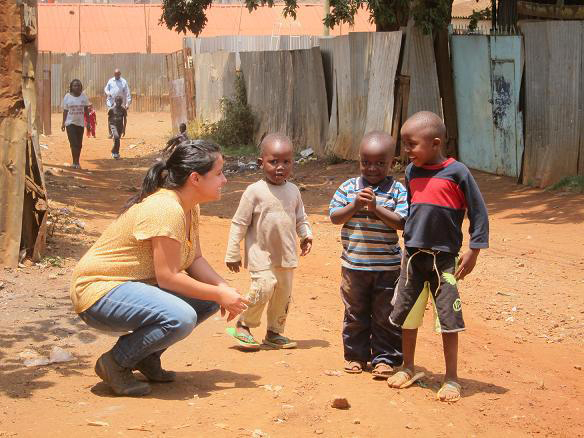Through this series of short interviews with former students of our masters course, we aim to trace their career paths since graduating and offer a glimpse of their current experiences working in the areas of architecture, urban planning and development.

Elaine in the Kibera slum during the masters course, in her internship with UN Habitat in Nairobi, Kenya.
In this interview, Elaine Morales tells about her work with a non-profit design center in the US and her desire to apply her architecture and community engagement skills in her home country of Puerto Rico.
Name: Elaine Morales Diaz
Age: 26
Nationality: Puerto Rican
Class of: 2012
Occupation: Community Designer
Location: Rio Grande Valley, Texas
Area of interest/specialty: Community Engagement and Post- Disaster/Conflict
Life goal: Do what I love near the people I love.
Professional goal: Initiate a Multidisciplinary Cooperation Group with friends.
1. What have you been working on since graduating from the masters program?
Since I graduated from the masters I started the process to obtain my architect’s license in the United States through the Architect Registration Examination (ARE) and the Intern Development Program (IDP). I also participated in a competition with two of my classmates and in studio reviews at the School of Architecture of the University of Puerto Rico. Currently I am working with bcWORKSHOP, a Dallas-based nonprofit community design center seeking to improve the livability and viability of communities through the practice of thoughtful design and making.
2. How/when did you become interested in development issues in the first place?
I became interested in development issues when I participated in the Community Design Workshop at the School of Architecture in Puerto Rico. I felt the traditional practice of the design and planning field wasn’t being thoughtful with our contemporary and social issues, locally and internationally.
3. What does your current job/project entail? Describe a regular work day.
I am starting to work with RAPIDO, a demonstration plan for a statewide rapid housing response after a natural disaster. I am leading the design piece of the project in the Rio Grande Valley. We are going to work with a wide group of stakeholders including experts, unskilled labor and the residents input for an inclusive and sustainable final proposal. A week of work entails meetings with the internal staff, partners and stakeholders, and the design and review of projects.

Community engagement: Elaine participates in a community workshop
4. In what ways do you feel the master prepared you for the work you are doing now?
I see the masters as my training program for community participation and disaster relief. The weekly courses and the internship gave me the tools to deal with challenges in the practice.
5. In your experience so far, what do you see as the major obstacles to sustainable urban development? What about progresses?
I think policies and regulations can be both part of progress or obstacles. I believe that the inclusion of residents in the improvement of regulations and guidelines is required to create and obtain a truly sustainable urban development.
6. Tell us about your most memorable working experience so far.
I think the most memorable moment was during a program review meeting where the community leader stated “I never thought we could have an architect available for us, until I heard about bcWORKSHOP and how they provide design for communities with scarce resources.” Being able to work directly with families and communities, and being part not only of the community engagement process but of the translation of these needs to spatial realities is one of the most fulfilling experiences as a designer.
Inclusive design: Elaine engages with the family of a single-family-housing project
7. What is your dream job?
After I get my license and become an experienced architect I would like to start a public interest design firm in Puerto Rico. My dream job would be to work with development issues in my home country.
8. What advice would you give to our incoming students interested in pursuing this line of work?
I would recommend using summer breaks to explore different types of practices and NGOs, to help in deciding which particular branch of the humanitarian and development world they prefer.
Thanks Elaine and we wish you the best of luck!

